中国戏剧PPT
合集下载
中国戏曲ppt课件
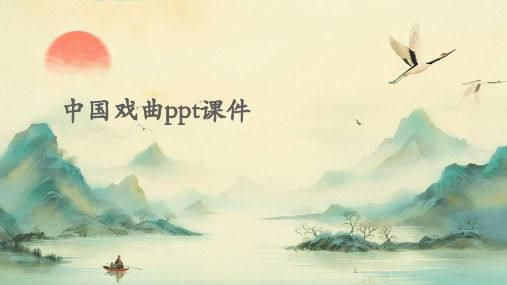
中国戏曲ppt课件
2024/1/26
1
2024/1/26
• 中国戏曲概述 • 戏曲表演艺术 • 戏曲音乐与唱腔 • 戏曲舞台美术 • 经典剧目赏析 • 中国戏曲的传承与发展
2
01
中国戏曲概述
2024/1/26
3
定义与特点
2024/1/26
定义
中国戏曲是一种综合性的舞台艺 术,集文学、音乐、舞蹈、美术 等多种艺术元素于一体。
感谢观看
2024/1/26
28
2024/1/26
10
03
戏曲音乐与唱腔
2024/1/26
11
声腔与板式
声腔
戏曲音乐的基础,不同剧种有不同的 声腔体系,如京剧的西皮、二黄,川 剧的高腔、昆腔等。
板式
声腔中的节奏形式,通过板眼(强拍 和弱拍)的变化来表现不同的情感和 气氛,如京剧中的原板、慢板、快板 等。
2024/1/26
12
乐器与伴奏
传统剧目的传承方式
探讨传统剧目如何通过口传心授、师徒相传等方式进行传 承,并分析这些传承方式的优缺点。
传统剧目的保护措施
介绍国家和地方政府对传统剧目的保护措施,如建立非物 质文化遗产名录、设立传承人制度等,并分析这些措施的 实施效果。
25
新编剧目的创新与发展
1
新编剧目的创作背景与动机
分析新编剧目产生的社会文化背景和创作动机, 如反映时代精神、探索新的表演手法等。
14
04
戏曲舞台美术
2024/1/26
15
布景与道具
2024/1/26
布景
戏曲舞台布景简约而富有象征性,常采用象征性物件或局部景象来代表整体环境 ,如以山水画代表室外景象,以桌椅代表室内环境。
2024/1/26
1
2024/1/26
• 中国戏曲概述 • 戏曲表演艺术 • 戏曲音乐与唱腔 • 戏曲舞台美术 • 经典剧目赏析 • 中国戏曲的传承与发展
2
01
中国戏曲概述
2024/1/26
3
定义与特点
2024/1/26
定义
中国戏曲是一种综合性的舞台艺 术,集文学、音乐、舞蹈、美术 等多种艺术元素于一体。
感谢观看
2024/1/26
28
2024/1/26
10
03
戏曲音乐与唱腔
2024/1/26
11
声腔与板式
声腔
戏曲音乐的基础,不同剧种有不同的 声腔体系,如京剧的西皮、二黄,川 剧的高腔、昆腔等。
板式
声腔中的节奏形式,通过板眼(强拍 和弱拍)的变化来表现不同的情感和 气氛,如京剧中的原板、慢板、快板 等。
2024/1/26
12
乐器与伴奏
传统剧目的传承方式
探讨传统剧目如何通过口传心授、师徒相传等方式进行传 承,并分析这些传承方式的优缺点。
传统剧目的保护措施
介绍国家和地方政府对传统剧目的保护措施,如建立非物 质文化遗产名录、设立传承人制度等,并分析这些措施的 实施效果。
25
新编剧目的创新与发展
1
新编剧目的创作背景与动机
分析新编剧目产生的社会文化背景和创作动机, 如反映时代精神、探索新的表演手法等。
14
04
戏曲舞台美术
2024/1/26
15
布景与道具
2024/1/26
布景
戏曲舞台布景简约而富有象征性,常采用象征性物件或局部景象来代表整体环境 ,如以山水画代表室外景象,以桌椅代表室内环境。
中国现当代戏剧欣赏-PPT模板
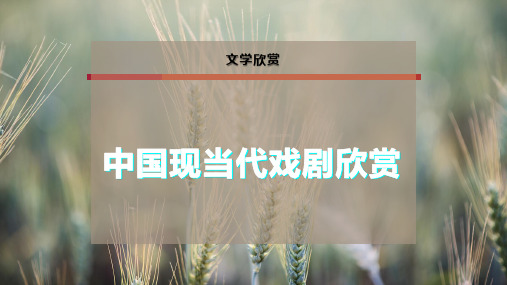
二、中国现当代戏剧欣赏实例
【赏析】曹禺(1910—1996),原名万家宝,字小石, 中国现代杰出的戏剧家。《雷雨》是一部惊心动魄的悲剧, 写的是一个封建资产阶级大家庭的矛盾。
《雷雨》一共四幕,本书节选的是第二幕,是解开谜团 的部分。这部分戏的构思独具匠心,在周公馆的客厅里,作 者用回顾和穿插的手法,把现实与过去巧妙地编织在一起, 一环套一环地使矛盾冲突尖锐化,从而逐步把戏剧推向高潮。 作者巧妙地利用周鲁两家几十年间的恩恩怨怨,非常自然地 展示了他们之间的血缘关系、阶级关系,深刻揭露了周朴园 罪恶的一生。剧中人物语言极富个性化,潜台词丰富,人物 形象塑造得非常成功,戏剧主题也得到了深刻的表现。
文学欣赏
过渡页
Transition Page
第2 页
中国现当代 戏剧欣赏
中国现当代戏剧的发展 中国现当代戏剧欣赏实例
第3 页
一、中国现当代戏剧的发展→(一)现代戏剧
中国现代戏剧始于19世纪末20世纪初,大致形成了两股创作潮流:一是20世纪初诞生后又逐渐成长 起来的现代话剧,一是从古典戏曲、西洋歌剧和话剧中吸取营养而形成的歌剧,二者在现代戏剧舞台上 以不同的方式、不同程度地影响着读者和观众。
“文革”十年,中国基本上没有戏剧创作,所谓的“样板戏” (《红灯记》《沙家浜》《奇袭白虎团》《海港》《智取威虎山》 同歌舞剧《白毛女》《红色娘子军》,以及“交响音乐”《沙家浜》 被称作“八大样板戏”)虽家喻户晓,也不过是当权者推行专制主 义的一种工具而已。
“文革”结束后,戏剧发展进入了新时期,政治化的倾向被对 艺术本体的关注所替代,出现了一批面貌一新的优秀剧目,例如: 《于无声处》《假如我是真的》《桑树坪纪事》《狗儿爷涅槃》 《绝对信号》等。
在国内,先后出现了进化团、新剧同志会、春阳社等, 演出了以辛亥革命为背景或题材的“文明戏”。“文明戏” 的特点是:内容上与时事政治、民事生活紧密相关,追求 现场的宣传、鼓动效果;形式上弃除了歌舞,以人物对话 为主。
中国现代戏剧.ppt
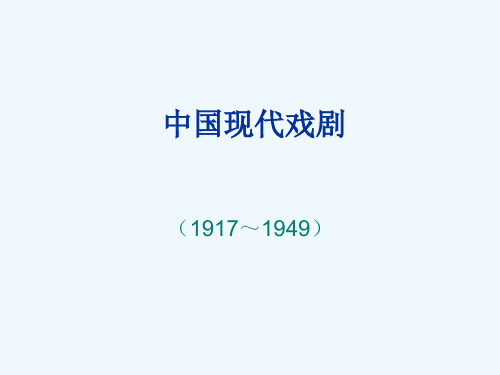
双元中心的网状 式结构。
2.主题结构 A.表层结构:社会矛盾冲突——新旧思想冲突,阶级 利益冲突 B.深层结构:对人性的探究,对“人生之谜”的索解 ――爱情纠葛,亲情冲突,性格矛盾,命运安排
3.主要人物
A.周朴园:半殖民地半封建社会的怪胎——积攒原 始资本的残酷——封建家长的专横自私——人性的挣扎 和复归
派 新剧”。
早期剧作
早期话剧文学的最初成果是“社会问题剧”。 1.胡适模仿易卜生的《娜拉》创作《终身大事》,开“社会问题 剧”之先。是中国现代文学史上的第一部话剧作品,拉开了中国现 代话剧创作的序幕。 2.陈大悲的《幽兰女士》从一个家庭着眼来分析社会问题。 3.欧阳予倩在自己的剧作中,首创了中国轻松喜剧形式.《泼妇》
没有喝。 朴 为什么? (停,向四凤)药呢?
蘩 (快说)倒了,我叫四凤倒了。
朴 (慢)倒了?哦?(更慢)倒了! ―― (向四凤)药 还有么?
四 药罐里还有一点。 朴 (低而缓慢)倒了来。 蘩 (反抗的)我不愿意喝这种苦东西。 朴 (向四凤,高声)倒了来。
[四凤走到左面倒药。] 冲 爸,妈不愿意,你何必这样强迫呢? 朴 你同你母亲都不知道自己的病在哪儿。(向蘩漪
中国现代戏剧
(1917~1949)
第六章 20年代的戏剧
一、中国现代Байду номын сангаас剧的萌芽与诞生 1.1907年2月,中国留日学生组织成立了春柳社,是最早对中 国现代话剧艺术进行自觉探讨与试验创造的剧社。主要成员有 李叔同 ,他们在东京演出了《茶花女》第三幕和根据林纾的翻 译小说改编成的五幕剧《黑奴吁天录》。 2.1910年底任天知发起,聚集了汪仲贤、欧阳予倩、陈大悲等 优秀戏剧人才,这是第一个职业性的新剧团,演出所谓“天知
7.丁西林的喜剧
2.主题结构 A.表层结构:社会矛盾冲突——新旧思想冲突,阶级 利益冲突 B.深层结构:对人性的探究,对“人生之谜”的索解 ――爱情纠葛,亲情冲突,性格矛盾,命运安排
3.主要人物
A.周朴园:半殖民地半封建社会的怪胎——积攒原 始资本的残酷——封建家长的专横自私——人性的挣扎 和复归
派 新剧”。
早期剧作
早期话剧文学的最初成果是“社会问题剧”。 1.胡适模仿易卜生的《娜拉》创作《终身大事》,开“社会问题 剧”之先。是中国现代文学史上的第一部话剧作品,拉开了中国现 代话剧创作的序幕。 2.陈大悲的《幽兰女士》从一个家庭着眼来分析社会问题。 3.欧阳予倩在自己的剧作中,首创了中国轻松喜剧形式.《泼妇》
没有喝。 朴 为什么? (停,向四凤)药呢?
蘩 (快说)倒了,我叫四凤倒了。
朴 (慢)倒了?哦?(更慢)倒了! ―― (向四凤)药 还有么?
四 药罐里还有一点。 朴 (低而缓慢)倒了来。 蘩 (反抗的)我不愿意喝这种苦东西。 朴 (向四凤,高声)倒了来。
[四凤走到左面倒药。] 冲 爸,妈不愿意,你何必这样强迫呢? 朴 你同你母亲都不知道自己的病在哪儿。(向蘩漪
中国现代戏剧
(1917~1949)
第六章 20年代的戏剧
一、中国现代Байду номын сангаас剧的萌芽与诞生 1.1907年2月,中国留日学生组织成立了春柳社,是最早对中 国现代话剧艺术进行自觉探讨与试验创造的剧社。主要成员有 李叔同 ,他们在东京演出了《茶花女》第三幕和根据林纾的翻 译小说改编成的五幕剧《黑奴吁天录》。 2.1910年底任天知发起,聚集了汪仲贤、欧阳予倩、陈大悲等 优秀戏剧人才,这是第一个职业性的新剧团,演出所谓“天知
7.丁西林的喜剧
中国戏剧ppt

岭南瑰宝--
省港大班 过山班 粤剧特点: 融汇了明清以来流入 广东海盐,昆山,梆子 等诸腔 珠江三角洲民间音乐
中 国 戏 剧
第 三 阶 段
第 二 阶 段
年 的 “ 女 伶 ” 时 期
年 的 “ 师 娘 ” 时 期
三 第 一个 阶 段阶 段 年
红线女
中 国 戏 剧
获得东方古典歌曲比
赛金质奖章作品 《昭君出塞》 《荔枝颂》
京胡
伴 奏 乐 器
高胡
谢谢同学们
中 国 戏 剧
再见!
1862---1917
1918---1945
1821---1861
的 “ 八 音 班 ” 时 期
中 国 戏 剧
广 东 开 平 人
原 名 : 邝 健 廉
红 线 女 花 旦
中 国 戏 剧
红线女 音质优美 音色 ----清脆秀丽 歌音 ----韵味浓厚 形成独树 一格的“红腔”
中国戏剧
岭南风情----粤剧
同学们,你们知道中国
中 国 戏 剧
的戏剧有哪些吗? 京剧 川剧 豫剧 评剧 越剧 昆曲 黄梅戏 河北梆子 湖南花鼓戏 粤剧
中 国 戏 剧
岭江安陕河河山天北 南苏徽西北南西津京
粤昆黄秦河豫上京京 剧曲梅腔北剧党剧剧 梆 梆 戏 子 子评 徽 剧 剧
京剧
中 国 戏 剧
粤剧
中国国粹 岭南瑰宝
大家一起来认识京剧和粤剧
中 国 戏 剧
京剧
请 欣 赏
《贵妃醉酒》
片段
关于戏剧的ppt
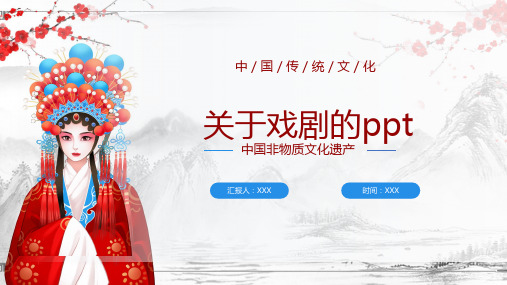
叁 .北方戏曲
四大名旦
01
梅艳芳
03
荀慧生
02
程砚秋
04
尚小云
叁 .北方戏曲
四大名旦经典曲目
锁麟囊 霸王别姬
程砚秋(1894--1961) 梅兰芳(1894— 1961)
昭君出塞
尚小云(1900— 1976)
红娘 荀慧生(1900—1968)
叁 .北方戏曲
四大须生经典曲目
02
武家坡
01
马连良(1901-1966)
中/国/传/统/文/化
关于戏剧的ppt 中国非物质文化遗产
汇报人:XXX
时间:XXX
壹 . 戏曲含义、特征与种类 贰 . 南方戏曲 叁 . 北方戏曲
壹
戏曲含义 特征与种类
壹 .戏曲含义、特征与种类
什么是戏曲?
中国戏曲 中国戏曲是一种历史悠久的综合舞台艺术 样式。
塑造人物形象 它揭示社会矛盾,反映社会生活。
03
是对生活原形进行选择、提炼、夸张和 美化,把观众直接带入艺术的殿堂。
02
综合性 中国戏曲是以唱、念、做、打的 综合表演为中心的戏剧形式。
04
戏曲艺术被恰当地称为有规则的自由动 作。
壹 .戏曲含义、特征与种类
怎样欣赏中国古代戏Βιβλιοθήκη ?新 01赏借
景 抒
欣 赏
02
情
曲
词
的
欣
音
赏 03
韵
曲
美
词
的
抒
情
性
壹 .戏曲含义、特征与种类
五大剧种:
剧还剧京 、有,剧 粤:此、 剧昆外越 等曲,剧 等、比、 。秦较黄
腔著梅 、名剧 花的、 鼓戏评 戏曲剧 、种、 川类豫
中国传统文化传承戏曲科普介绍PPT图文课件
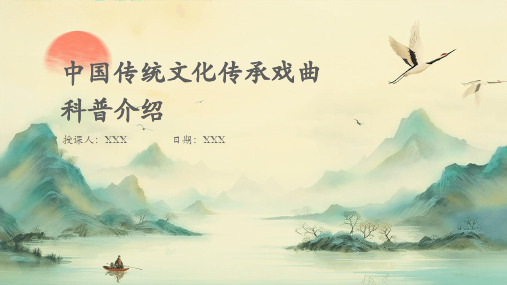
戏曲在中国文化中的地位
文化传承
戏曲是中国传统文化的重要组成部分,承载着丰富的历史和文化信息,是传承 和弘扬中华优秀传统文化的重要途径之一。
艺术瑰宝
戏曲是中国艺术的瑰宝之一,其表演艺术具有高度的规范化和程式化,体现了 中华民族独特的审美观念和艺术风格。同时,戏曲也是世界文化遗产的重要组 成部分,对于世界文化的发展也有着重要的影响。
意境和场景氛围。同时,舞台布景还具有象征意义,如山水、云雾等元
素,都代表着特定的含义和情感。
03
经典剧目与剧情简介
《牡丹亭》剧情简介及分析
剧情简介
杜丽娘在梦中与柳梦梅相遇并相爱,醒来后因思念柳梦 梅而病逝。柳梦梅得知杜丽娘的死讯后,掘坟救活了她 ,最终二人结为夫妻。 《牡丹亭》以浪漫主义手法描绘了爱情的力量,展现了 人性对于自由和爱情的追求。
中国传统文化传承戏曲
科普介绍
授课人:XXX
日期:XXX
➢ 戏曲概述与历史发展 ➢ 戏曲表演艺术形式与技巧 ➢ 经典剧目与剧情简介 ➢ 戏曲传承与保护现状分析 ➢ 戏曲在当代社会中的影响与价值 ➢ 未来发展趋势预测与展望
01
戏曲概述与历史发展
戏曲定义及特点
戏曲定义
戏曲是中国传统戏剧形式,融合了唱 、念、做、打、舞等多种表演形式, 以虚拟化的舞台、程式化的表演和规 范化的服饰为特点。
《牡丹亭》是明代戏曲家汤显祖的代表作之一,讲述了 杜丽娘与柳梦梅的爱情故事。
分析
剧中对于封建礼教的批判和对人性解放的追求,具有深 刻的社会意义。
《西厢记》剧情简介及分析
剧情简介
《西厢记》是元代戏曲家王实甫的代表作之一,讲述了张生与崔莺莺的爱情故事。
张生与崔莺莺在普救寺相遇并一见钟情,随后张生通过书信向崔莺莺传情。崔莺莺的母亲为了家族利益 要将她许配给郑恒,但崔莺莺却爱上了张生。经过一系列波折,张生与崔莺莺终于结为夫妻。
中国戏剧史课件 251页PPT文档
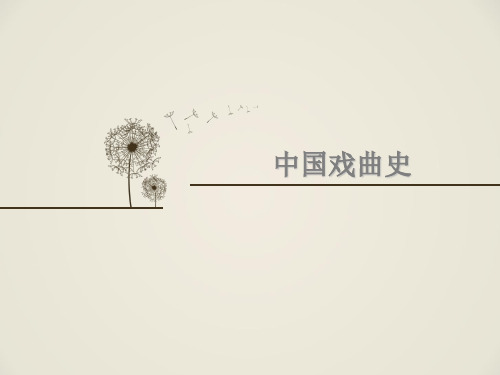
戏曲出,泼少年化之,而后淫哇盛,正
声歇。
吴用章传》
——[宋]刘埙《水云村稿·词人
其它文献中的“戏曲”名称
元人陶宗仪《南村辍耕录》卷二十七《杂剧曲名》有“戏 曲”一词,凡二见。 明人魏良辅《南词引正》:“清唱谓之冷唱,不比戏曲。 戏曲藉锣鼓之势,有躲闪省力,知者辨之。”
近代学者王国维撰写了《戏曲考原》《宋元戏 曲考》等著作,最终确定了用以指称中国传统戏剧样式的 “戏曲”概念。
古梵剧(公元后)
纪后)
中国古典戏曲(十世
北宋灭亡后,中国的南北方出现了不同的戏曲发展形式。
北方由宋杂剧演化为金院本(行院的脚本)和元杂剧。明 清两代杂剧发展变化并走向消亡。
明清时,南戏演化为传奇。
清代中期(乾隆后期),以京剧为代表的地方戏兴起,以 昆剧为代表的传奇走向衰落。
中国戏曲史
目录
第一章 戏曲概说 第二章 从先秦到唐五代的古剧 第三章 杂剧 第四章 南戏和传奇 第五章 地方戏 第六章 对戏曲发展的展望
第一章 戏曲概说
一、什么是戏曲 二、戏曲 戏剧 曲艺 三、戏曲的基本特征 四、戏曲的发展过程 五、戏曲的价值和地位
一、什么是戏曲?
“戏曲”名称的最早出处
至咸淳(1265-1274),永嘉
《宋元戏曲史》目录
第1章 上古至五代之戏剧 第3章 宋之小说杂戏 第5章 宋官本杂剧段数 第7章 古剧之结构 第8章 元杂剧之渊源 第10章 元剧之存亡 第11章 元剧之结构 第13章 元院本 第14章 南戏之渊源及时代 第15章 元南戏之文章
第2章 宋之滑稽戏 第4章 宋之乐曲
第6章 金院本名目 第9章 元剧之时地 第12章 元剧之文章
在现代,戏剧有时专指西方话剧,和古代戏曲 形成并列关系。 属种关系。
综合性学习《中国戏剧》优秀课件
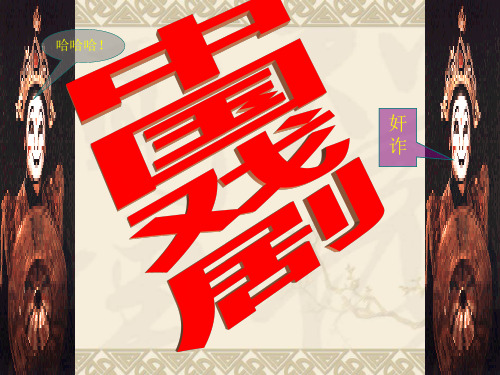
❖ 粉红武将骁勇善战、残暴,如典韦、 宇文成都等。
❖ 黑脸:表示忠耿正直、铁面无私,或粗率莽 撞的人物。如包拯、张飞、夏侯渊等。
❖ 白脸:又分水白脸和油白脸。水白脸表示阴 险奸诈、善用心计。如曹操、赵高、严嵩等。
❖ 绿脸:表示侠骨义肠、性格暴躁的人物。如 程咬金、青面虎等。
哈哈哈!
奸 诈
❖ 戏曲指的是中国传统的戏剧。戏曲的内涵包 括唱念做打,综合了对白、音乐、歌唱、舞 蹈、武术和杂技等多种表演方式,不同于西 方将歌剧、舞剧、话剧 戏曲是汉族传统
艺术之一,剧种繁多有趣,表演形式载歌载 舞,又说又唱,有文有武,集“唱、做、念、 打”于一体
❖ 其主要特点,以集汉族古典戏曲艺术大成的 京剧为例,一是男扮女、女扮男;二是划分 生、旦、净、丑四大行当;三是有夸张性的 化装艺术--脸谱;四是“行头”(即戏曲服装 和道具)有基本固定的式样和规格;五是利用 “程式”进行表演。
中国戏曲发展
先秦时期→汉魏时期→唐宋金时期→元朝→元末明清 时期→近代 元代兴盛
经过长期的发展演变,逐步形成了以“京剧、越剧、 黄梅戏、评剧、豫剧”五大戏曲剧种为核心的中华戏 曲百花苑。
❖ 云南省 ❖ 滇剧、云南花灯戏、昆明曲剧、关索剧、傣
剧、白剧、彝剧、云南壮剧。
脸谱人物性格
❖ 红脸:表示忠勇耿直,有血性的勇烈人物。 如关羽、赵匡胤、姜维等。
❖ 黑脸:表示忠耿正直、铁面无私,或粗率莽 撞的人物。如包拯、张飞、夏侯渊等。
❖ 白脸:又分水白脸和油白脸。水白脸表示阴 险奸诈、善用心计。如曹操、赵高、严嵩等。
❖ 绿脸:表示侠骨义肠、性格暴躁的人物。如 程咬金、青面虎等。
哈哈哈!
奸 诈
❖ 戏曲指的是中国传统的戏剧。戏曲的内涵包 括唱念做打,综合了对白、音乐、歌唱、舞 蹈、武术和杂技等多种表演方式,不同于西 方将歌剧、舞剧、话剧 戏曲是汉族传统
艺术之一,剧种繁多有趣,表演形式载歌载 舞,又说又唱,有文有武,集“唱、做、念、 打”于一体
❖ 其主要特点,以集汉族古典戏曲艺术大成的 京剧为例,一是男扮女、女扮男;二是划分 生、旦、净、丑四大行当;三是有夸张性的 化装艺术--脸谱;四是“行头”(即戏曲服装 和道具)有基本固定的式样和规格;五是利用 “程式”进行表演。
中国戏曲发展
先秦时期→汉魏时期→唐宋金时期→元朝→元末明清 时期→近代 元代兴盛
经过长期的发展演变,逐步形成了以“京剧、越剧、 黄梅戏、评剧、豫剧”五大戏曲剧种为核心的中华戏 曲百花苑。
❖ 云南省 ❖ 滇剧、云南花灯戏、昆明曲剧、关索剧、傣
剧、白剧、彝剧、云南壮剧。
脸谱人物性格
❖ 红脸:表示忠勇耿直,有血性的勇烈人物。 如关羽、赵匡胤、姜维等。
中国戏剧史导论PPT课件
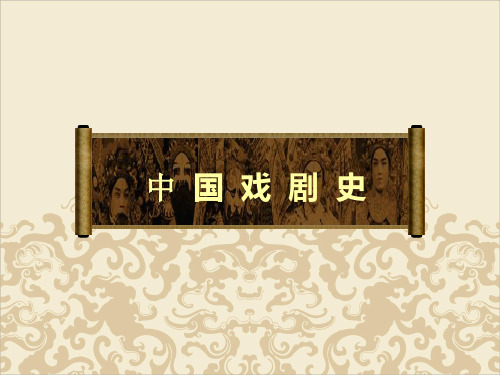
但也有人把它们看作是历史剧中的一个特殊门类。
2021/3/7
CHENLI
16
二、戏剧形态与分类
(2)现代剧 对现代生活基础题材的艺术创作,中国现今流行 的现代剧深刻地表现和反映了现代社会文化的进 步与广大人民群众在改革创新时代体现出来的精 神风貌,通过艺术加工后的现代剧人物刻画手法 细致入微,形象生动,活灵活现地塑造了很多具 有美好形象的戏剧人物。
➢(5)木偶戏
由幕后演员操纵,用木偶来表演故事的戏剧形式。
➢(6)皮影戏
一种用皮制(或纸制)的平展玩偶演出的戏剧形式。
2021/3/7
CHENLI
7
二、戏剧形态与分类
2.按戏剧冲突的性质及效果分类
❖(1)喜剧 ❖(2)悲剧 ❖(3)正剧
2021/3/7
CHENLI
8
二、戏剧形态与分类
❖(1)喜剧:指以可笑性为外在表现特征的一 类戏剧。 ❖戏剧类别之一。用夸张手法讽刺和嘲笑丑恶、 落后的现象,突出这种现象本身的矛盾和它与健 康事物的冲突,台词风趣,往往引人发笑,结局 大多轻松圆满。 ❖鲁迅《坟‧再论雷峰塔的倒掉》:“喜剧将那 无价值的撕破给人看。”
尔托的残酷戏剧、贝克特等人的荒诞派戏剧等等。
狭义的“先锋派戏剧”特指20世纪20年代法国以
贝梯、杜林、日瓦特和比艾夫等为代表的戏剧活
动。
2021/3/7
CHENLI
13
二、戏剧形态与分类
❖4.按照题材所反映的时代分类 ❖历史剧 ❖现代剧
2021/3/7
CHENLI
14
二、戏剧形态与分类
(1)历史剧
象的忠实再现,按照历史提供的确凿人物关系进行剧作
结构,并以历史事件的自然进程安排剧情进展。
- 1、下载文档前请自行甄别文档内容的完整性,平台不提供额外的编辑、内容补充、找答案等附加服务。
- 2、"仅部分预览"的文档,不可在线预览部分如存在完整性等问题,可反馈申请退款(可完整预览的文档不适用该条件!)。
- 3、如文档侵犯您的权益,请联系客服反馈,我们会尽快为您处理(人工客服工作时间:9:00-18:30)。
CATALOG
➢ Chinese traditional Opera ➢ History of Chinese Opera Development ➢ Classification of Opera ➢ The Inheritance and Present Situation of Opera
1 Chinese traditional Opera
Comprehensiveness, virtuality and stylization are the main artistic features of Chinese operas. These characteristics, condense the essence of Chinese traditional aesthetics, constitute a unique view of drama, making Chinese opera shine its unique artistic brilliance on the great stage of world opera culture.
Tang dynasty During the Tang Dynasty, the unprecedented integration of North and South cultures and large-scale exchanges of Chinese and foreign cultures created a good social atmosphere for the prosperity of literature and art. Haiyou comic performances in the Pre-Qin Dynasty evolved into military operas, which became the most important theatrical style in the Tang Dynasty. The classifications of the roles and acts in the military play are relatively clear, and there are relatively fixed design arrangements in the plot.
Chinese Opera:Chinese Opera mainly includes drama and drama. Traditional Chinese opera is a traditional Chinese drama. After a long period of development and development, Chinese opera gradually formed the core of the Chinese opera with five major operas, namely Peking Opera, Shaoxing opera, Huangmei Opera, Ping Ju opera and Henan opera. Drama is a form of Western drama introduced in the 20th century.
Yuan dynasty Yuan Dynasty is the golden age in the history of Chinese drama. The drama of the Yuan Dynasty emerged as the mainstream of the development of literature and art by means of the northern opera drama (Yuan zaju) and the southern opera (Southern Drama), which was the mature drama art form and the emergence of a large number of outstanding drama works, and opened a new world for the development of Chinese drama. The legends of Ming and Qing Dynasty inherited the achievements of drama art of Yuan Dynasty, especially along the development vein of Southern Opera, which occupied the stage of drama from the early Ming Dynasty to the late Qing Dynasty for nearly 400 years.
பைடு நூலகம்
Song dynasty In the Song Dynasty, the Tang Dynasty's "Joining the Army Opera" and other operas of song and dance further developed and merged to produce Song Opera. Its duplicate is generally composed of three parts: Yanduan, Zhengzaju and miscellaneous costumes. The roles in the stage are male protagonist (末泥), female protagonist (引戏), laughed person (副净), laughed person (副来), official (装孤). Although song Zaju is still a farce, its dramatic structure and role play already have the rudiment of Chinese drama and closer to the mature drama.
3 Classification of Opera
Beijing opera Beijing Opera is one of the five major operas in China. Its layout is focused on freehand brushwork and accompaniment with Hu Qin and Gong and drum. It is regarded as the quintessence of Chinese culture. In the Qianlong years of the Qing Dynasty, the performers who had performed in the South entered Beijing in succession. They cooperated with artists from Hubei, and accepted some of the operas, tunes and performing methods of Kunqu Opera and Shaanxi opera. After the formation of Peking Opera, it began to develop rapidly in the court of the Qing Dynasty until the unprecedented prosperity of the Republic of China.
Ming and Qing Dynasties The legend of Ming and Qing Dynasty is a form of opera developed from Southern Opera of Song, Yuan and Yuan Dynasties. It originated in the late Yuan Dynasty, spread in the early Ming Dynasty, flourished in the Jiajing Period of the Ming Dynasty, flourished in Wanli, and extended to the late Ming and early Qing Dynasties.
2 History of Chinese Opera Development
Han Dynasty to Sui Dynasty From time to time in Qin and Han Dynasties, there were "hundred operas" which included various acrobatic illusions, songs and dances dressed up as characters or actions, simple narrative performances and other ancient music and dance, and acrobatic performances, which reached its peak at the time of Emperor Wudi of Han Dynasty. One of the most outstanding is Huanggong in the East China Sea, in which one acts as Huanggong and one acts as a tiger to compete in a gladiatorial contest to express the content in a prescribed plot. It can be said that the performance of Huang Gong in the East China Sea has the original form of drama, which is of great significance in the history of Chinese drama.
➢ Chinese traditional Opera ➢ History of Chinese Opera Development ➢ Classification of Opera ➢ The Inheritance and Present Situation of Opera
1 Chinese traditional Opera
Comprehensiveness, virtuality and stylization are the main artistic features of Chinese operas. These characteristics, condense the essence of Chinese traditional aesthetics, constitute a unique view of drama, making Chinese opera shine its unique artistic brilliance on the great stage of world opera culture.
Tang dynasty During the Tang Dynasty, the unprecedented integration of North and South cultures and large-scale exchanges of Chinese and foreign cultures created a good social atmosphere for the prosperity of literature and art. Haiyou comic performances in the Pre-Qin Dynasty evolved into military operas, which became the most important theatrical style in the Tang Dynasty. The classifications of the roles and acts in the military play are relatively clear, and there are relatively fixed design arrangements in the plot.
Chinese Opera:Chinese Opera mainly includes drama and drama. Traditional Chinese opera is a traditional Chinese drama. After a long period of development and development, Chinese opera gradually formed the core of the Chinese opera with five major operas, namely Peking Opera, Shaoxing opera, Huangmei Opera, Ping Ju opera and Henan opera. Drama is a form of Western drama introduced in the 20th century.
Yuan dynasty Yuan Dynasty is the golden age in the history of Chinese drama. The drama of the Yuan Dynasty emerged as the mainstream of the development of literature and art by means of the northern opera drama (Yuan zaju) and the southern opera (Southern Drama), which was the mature drama art form and the emergence of a large number of outstanding drama works, and opened a new world for the development of Chinese drama. The legends of Ming and Qing Dynasty inherited the achievements of drama art of Yuan Dynasty, especially along the development vein of Southern Opera, which occupied the stage of drama from the early Ming Dynasty to the late Qing Dynasty for nearly 400 years.
பைடு நூலகம்
Song dynasty In the Song Dynasty, the Tang Dynasty's "Joining the Army Opera" and other operas of song and dance further developed and merged to produce Song Opera. Its duplicate is generally composed of three parts: Yanduan, Zhengzaju and miscellaneous costumes. The roles in the stage are male protagonist (末泥), female protagonist (引戏), laughed person (副净), laughed person (副来), official (装孤). Although song Zaju is still a farce, its dramatic structure and role play already have the rudiment of Chinese drama and closer to the mature drama.
3 Classification of Opera
Beijing opera Beijing Opera is one of the five major operas in China. Its layout is focused on freehand brushwork and accompaniment with Hu Qin and Gong and drum. It is regarded as the quintessence of Chinese culture. In the Qianlong years of the Qing Dynasty, the performers who had performed in the South entered Beijing in succession. They cooperated with artists from Hubei, and accepted some of the operas, tunes and performing methods of Kunqu Opera and Shaanxi opera. After the formation of Peking Opera, it began to develop rapidly in the court of the Qing Dynasty until the unprecedented prosperity of the Republic of China.
Ming and Qing Dynasties The legend of Ming and Qing Dynasty is a form of opera developed from Southern Opera of Song, Yuan and Yuan Dynasties. It originated in the late Yuan Dynasty, spread in the early Ming Dynasty, flourished in the Jiajing Period of the Ming Dynasty, flourished in Wanli, and extended to the late Ming and early Qing Dynasties.
2 History of Chinese Opera Development
Han Dynasty to Sui Dynasty From time to time in Qin and Han Dynasties, there were "hundred operas" which included various acrobatic illusions, songs and dances dressed up as characters or actions, simple narrative performances and other ancient music and dance, and acrobatic performances, which reached its peak at the time of Emperor Wudi of Han Dynasty. One of the most outstanding is Huanggong in the East China Sea, in which one acts as Huanggong and one acts as a tiger to compete in a gladiatorial contest to express the content in a prescribed plot. It can be said that the performance of Huang Gong in the East China Sea has the original form of drama, which is of great significance in the history of Chinese drama.
